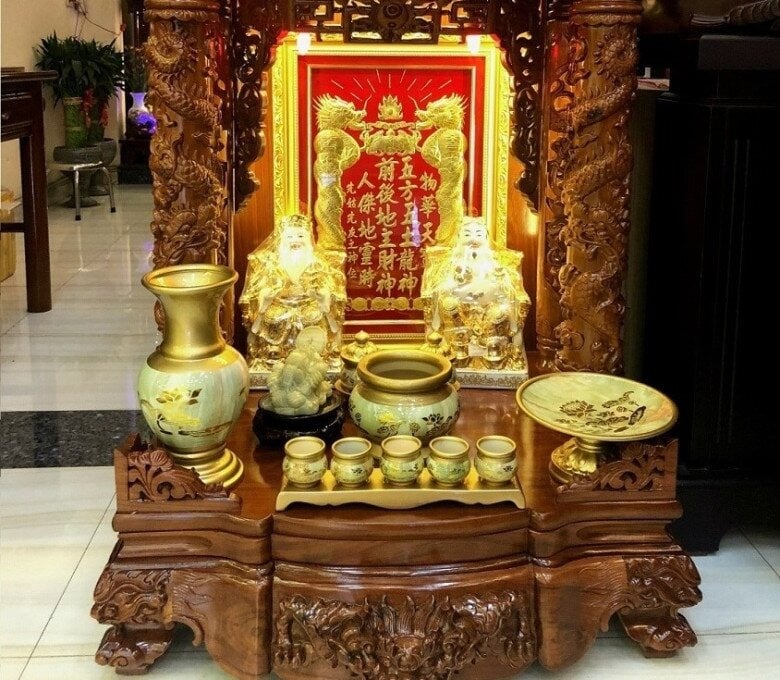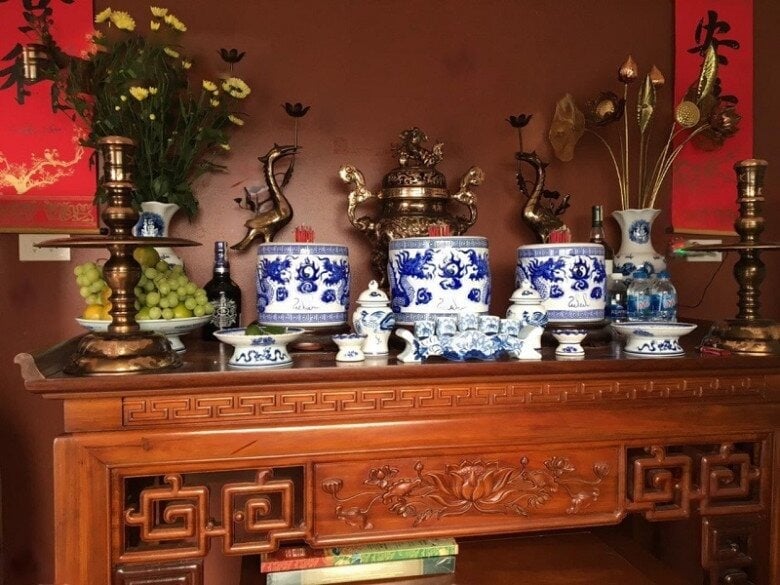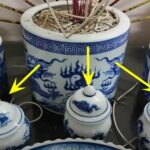The offering of a water bowl is an indispensable part of any altar, be it an ancestral or a God of Wealth altar. Water symbolizes purity and cleanliness, and placing a water bowl on the altar demonstrates one’s sincerity and respect for their ancestors and deities.
In Feng Shui, water also represents wealth and prosperity. Placing a water bowl on the altar is believed to bring positive energy and good fortune to the family. However, many people wonder about the appropriate number of water bowls to place on the altar – should it be three or five?
The Number of Water Bowls on an Altar: 3 or 5?
The water bowls are usually placed on a ceramic stand, creating a set called a ‘kỷ chén’. The number of bowls is typically odd, with three or five being the most common. In traditional beliefs, even numbers are associated with yin (femininity), while odd numbers represent yang (masculinity). Therefore, when offering sacrifices to the deceased, an odd number is preferred.
So, should one place three or five water bowls on the altar? In reality, the choice between three or five clean water bowls depends on the beliefs of the family and the size of the altar.

How Many Water Bowls Should Be Placed on an Altar: 3 or 5?
If you opt for a set of five bowls, the three central bowls represent the Buddha and the Saints, while the two side bowls symbolize the female and male ancestors and the family’s lineage. The set of five bowls can also represent the five elements (metal, wood, water, fire, and earth) or the five constants (humanity, righteousness, propriety, wisdom, and trust).
For smaller altars or wall-mounted altars, three water bowls may be more space-efficient. A set of five bowls is often better suited for larger altars or altars dedicated to both Buddhist and ancestral worship (three-tiered altars).
Notes on Placing the ‘Kỷ Chén’ Water Bowl Set on the Altar
The ‘kỷ chén’ water bowl sets come in various designs and materials such as ceramic, glazed porcelain, or crackled glaze. However, if you use ceramic altar pieces, avoid combining them with copper water stands. Conversely, porcelain bowls are not typically used with copper altars.

Notes on Placing the ‘Kỷ Chén’ Water Bowl Set on the Altar
You can choose between curved or tiered water bowls, depending on your family’s aesthetic preferences, as long as they match the other items on the altar.
When placing the ‘kỷ chén’ on the altar, keep the following in mind:
Do not place the water bowl behind the incense burner; instead, place it in front of the offering tray. When not in use, lower the bowl and avoid leaving an empty bowl on the altar.
Avoid using cracked or broken bowls. If your set has any such issues, replace it with a new one immediately.
The Enchanting Significance of Planting Violets: A Guide to Unlocking the Beauty of Nature at Your Doorstep.
The humble Jasmine, or more poetically known as “Wall Violet”, is an exquisite ornamental plant with a deep-rooted history in ancient cultures. Its delicate beauty and enchanting fragrance have captivated generations, becoming a beloved fixture in homes and gardens. Beyond its aesthetic appeal, the Wall Violet holds a special significance in feng shui, believed to bring good luck and positive energy to its surroundings. This ancient belief, coupled with the plant’s intrinsic beauty, has made it a favorite among those with a keen eye for both aesthetics and auspicious symbolism.
The Secret to Wealth: Unveiling the Ancient Practice of the Three Jars of Rice, Salt, and Water on the Ancestral Altar
In the realm of feng shui, placing three jars of rice, salt, and water on an altar is a symbolic gesture of inviting good fortune and prosperity into one’s home. This ancient practice is believed to attract positive energy and create a harmonious environment, bringing balance and abundance to those who embrace it.








































